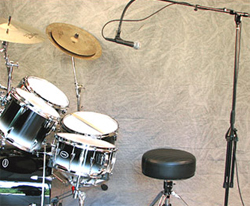A drummer who also sings while playing can impact drum sound due to the presence of an additional microphone on or around the kit.
Here are some ways I deal with this issue.
Go for maximum isolation. A headset mic with a lot of rear rejection like the Crown Audio CM-311A headworn differoid (photo below). With maximum rear rejection, this headset really helps in keeping vocals separate from the drum kit.
I’ve used the CM-311A numerous times and it does do a really nice job of creating that separation. However, almost every drummer I’ve worked with complains about headworn/headset mics because they don’t have the the ability to change distance and orientation. They need to be counseled to overlook this issue in order to contribute to improved overall sound quality.
Go for good isolation and some flexibility. I usually accomplish this with a mic that “hangs over” the drummer’s head, with the rear of the mic pointed somewhat upward. It should be a cardioid pattern mic, which places the maximum rejection toward the cymbals, helping to keep drum wash out of the vocal mic.
This approach also generally pleases the drummers because they’re able to use the physical characteristics of the microphone to their advantage while attaining some separation from the drums.
Go for some isolation and comfort. A number of drummers that I work with prefer the mic to be on a boom coming over their right shoulder. The back end of the mic is usually pointed somewhere between the high-hat and the first tom.
Specifically, some of them have told me that they like this set-up because when they’re “in the groove” on the hi-hat, they’re more comfortable singing with their head turned towards the right. Once again, a mic with a cardioid pattern helps foster separation between drums and vocals.
Go for comfort and something different. Recently I’ve been using a hypercardioid mic on drummers with the “over the shoulder” set-up noted directly above, positioned so that the back (where a hypercardioid also picks up) of the mic is pointed at the hi-hat.
In this configuration, I then eliminate the hi-hat mic and use the rear side of the hypercardioid to pick up its sound from the hi hat. This approach has worked well, because I leave the vocal mic hot the entire time (even if the drummer is not singing on a particular song), and doing this keeps the drum sound consistent whether the drummer is singing or not.
I also like the tightness of the pattern, so the ride cymbal and crash cymbal don’t enter into the mic as much as with a cardioid. A side bonus—if you’re short on channels, you just picked up an extra one by having the mic serve a dual purpose.
One note of caution with this set-up: make sure the drummer does not push the mic out of the way when not singing. If it moves, the hi-hat sound will change or more likely disappear.
For me, the bottom line on mic’ing a drummer comes back to some basics:
1) Make sure the mic position works for both you and the drummer. (This is just common sense.) If the drummer is uncomfortable, he or she is not going to play his/her best. If the mic is in the absolute worst position, you’re going to pick up too much of the kit. So find something that works for both of you.
2) Know what you’re doing and why you’re doing it! (Again, common sense.) If you know why something sounds like it does, you can modify your approach for a better result.
3) Experiment. Don’t get locked into the idea “this is how I always do it.” I stumbled into the hypercardioid set-up when all I had left for a vocal mic was a Shure Beta 87. When I turned on the mic, I realized I didn’t need the hi-hat mic, and began playing around with position of the Beta 87 while at the same time listening to the drummer and his needs on positioning.
As I always say, TnT (tech and talent) when working together is explosive. Let’s just make it a positive explosion not a negative one.
Gary Zandstra is a professional AV systems integrator with Parkway Electric and has been involved with sound at his church for more than 25 years.



















